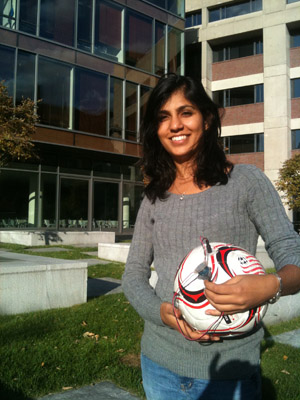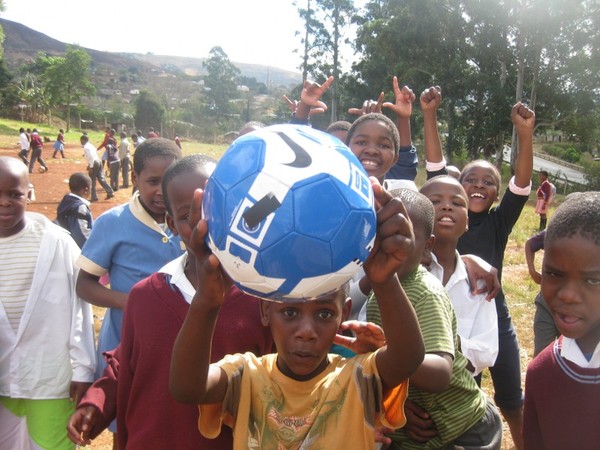Soccer Ball Brings Off-Grid Electricity Onto the Field
CAMBRIDGE, Massachusetts -- A group of Harvard students is harnessing the power of the world's most popular sport. They've designed a soccer ball that generates electricity with every kick. After a game, it can power a small light.
Though it's still a prototype, Popular Mechanics recently named sOccket one of its breakthrough innovations of the year. Hemali Thakkar, one of the co-creators of sOccket, showed me the product at Harvard's campus. It looks like an average white ball, but on the inside, she said, "there's a magnet that goes back and forth through the inductive coil, which allows a current to be captured in a capacitor and electricity to be stored." The extra hardware adds 6 ounces to the standard 15-ounce soccer ball.
"About 15 minutes of kicking the ball allows us to use a single LED for three hours," Thakkar said. A standard 90-minute game could generate close to 12 hours of light. The sOccket's socket is a small DC jack in the middle of one of the ball's panels. Thakkar plugged in an LED. It glowed modestly in the daylight, but Thakkar assured me, "when it's pitch dark, it's amazing how a single LED can make such a big difference."
Poor places that lack access to electricity is where sOccket hopes to make the biggest difference. The UN Development Program estimates that nearly 80 percent of the citizens of the 50 poorest nations have no access to electricity. People rely on unsustainable, unhealthy energy sources. To generate light, many burn kerosene. Its fumes are a major cause of health problems in developing countries and the environmental impact of kerosene is severe as well -- the yearly carbon dioxide emissions from all those lamps around the world equals the emissions from about 38 million cars.
This past summer, the sOccket team took their prototype to Nigeria, Liberia and South Africa to test it where the need for clean electricity and love of soccer was the highest. The home of the 2010 World Cup gave the sOccket inventors a great opportunity to see how their ball fared on some no-frills fields.

Durability is the name of the game. Heather Fleming heads the non-profit Catapult Design, which has done extensive research for clients trying to supply soccer balls to African nations. She says that the average African soccer ball has a brief field life of 7-90 days. The current sOccket has an exposed outlet, which makes it especially vulnerable to environmental conditions. Thakkar's team is working on that problem, as well as other improvements. "This is still our prototype 2.0," she said. "We hope that we will reduce weight, increase durability, increase the capture of electricity and make it a better product."
The sOccketeers are also going to have to get the ball's price down. The prototype costs $70 for a design shop to manufacture but the team hopes that as they scale up production the ball will cost no more than $10 to make. They want to have a for-sale version of the ball on American shelves next summer and a subsidized or free version distributed to groups like Whizzkids in South Africa soon after.
For the developing world, Fleming doesn't support the buy-one, give-one-away model. "We don't try to do any work for free and we discourage subsidies." Giving away products ruins local markets for balls, Fleming explained. "[Giveaways] handicap African entrepreneurs and people don't value it as much." It's only when designers tap local businesspeople and workers that they create products that can succeed long-term.
"95 percent of all products and technology directed at the world's poorest market fail," Fleming said. "Market based solutions are what makes it last."
Thakkar and her co-creators are exploring local production options where rural residents would assemble and sell the balls themselves. "That's definitely the biggest idea that we are thinking about right now," she said.
Images: 1. An early prototype in KwaZulu Natal, South Africa for field testing. WhizzKids United. 2. Hemali Thakkar holding the sOccket 2.0 in Cambridge. Ike Sriskandarajah.
